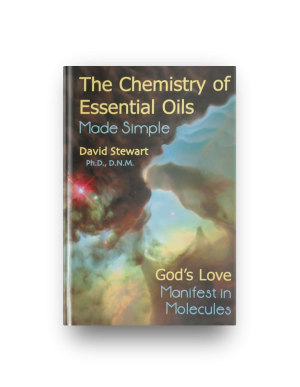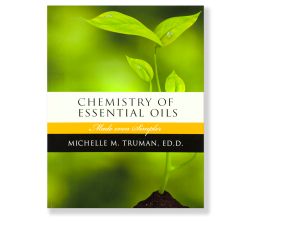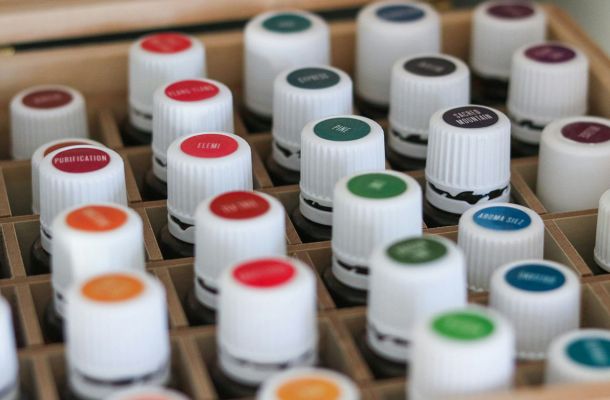Sensitivities to Essential Oils – Volume 4, Number 1
Please feel free to share this newsletter!

Raindrop Messenger
Official Newsletter of CARE
The Center for Aromatherapy Research and Education
12923 BCR 800, Marble Hill, Missouri USA 63764
(573) 238-4846
NOTE: The information in this newsletter is intended for education purposes only. It is not provided in order to diagnose, prescribe, or treat any disease, illness, or injured condition of the body or mind. Anyone suffering from any disease, illness, or injury should consult with a physician or other appropriate licensed health care professional.
Sensitivities to Essential Oils
By David Stewart, PH.D., R.A.
Originally Posted January/February 2006
There are a couple of ways one can be sensitive to essential oils, but an allergic reaction is not one of them. Allergies are erroneous immune responses to proteins, peptides, and amino acids – all nitrogen compounds, none of which are found in essential oils.
You can have an allergic reaction to a vegetable oil such as olive, corn, peanut, walnut, almond, etc., since these are cold pressed and can contain small amounts of proteins. For example, occasionally a person can develop an allergy to an oil blend such as Valor, which is sold by Young Living. The allergy is not due to the essential oils of spruce, frankincense, rosewood, and blue tansy in the blend. It is due to the almond oil in the blend. So read your labels. What may appear to be an allergic reaction to a blend of essential oils may be due to a carrier oil contained in the blend.
You can also have an allergic reaction to citrus oils which are cold pressed from the rind. However, while we refer to citrus oils such as orange, lemon, lime, and grapefruit as “essential oils,” strictly speaking they are not. By definition, a true essential oil must be steam distilled, not expressed.
There are also oils extracted by solvents such as onycha, jasmine, and neroli. Strictly speaking, they too are not true essential oils. Technically, they should be called absolutes, not essential oils. One can have a true allergic reaction to these because, like the citrus oils, they have not passed through a distillation process and can contain traces of proteins, peptides, or amino acids.
Because of the nature of distillation by heat, steam, and water, that true essential oils must undergo, they do not contain the necessary compounds to trigger allergies because these compounds do not pass through the distillation process.
Hence, sensitivities to essential oils, in the sense of allergic reactions, are not possible. Allergic sensitivities are due to the body developing antibodies in response to certain nitrogenous molecules. No one has ever
found antibodies in humans from essential oils. So if one has a reaction to an essential oil, it is something else. Not an allergy.
Hot Oils
There are oils that are naturally hot, such as oregano, thyme, mountain savory, cinnamon, cassia, and a few others. This is because of their phenolic compound content which cleanses our cells and paves the way to healing. Such oils can be taken internally via capsules or applied to the skin directly with caution or diluted with a fatty oil.
If burning or irritation occurs to the skin from such oils, prompt application of a vegetable oil layered over the essential oil will take care of the problem in short order.
The same thing applies if you get an essential oil in your eyes or if you swallow a hot oil, like oregano, and it burns your mouth and throat. Don’t use water, use a vegetable oil for immediate relief. Pour it directly in the eyes or take it orally if your mouth or throat are affected.
Detox Reactions
As for sensitivities to essential oils that produces a skin ash or other allergic-like symptoms such as headaches or nausea, this is always a detox reaction. While allergic reactions get worse and worse with each exposure to the offending substance (allergen), detox reactions eventually get less and less severe with each exposure to an essential oil until it disappears completely once the toxins are cleared from the system.
When one has a detox reaction from an essential oil (which is a good thing), they need to back off from using oils for a while and increase their water intake and, perhaps, get into a cleansing routine for a month or so, going light on the use of essential oils for a while. What is happening in this kind of sensitivity is that the oils are detoxing too rapidly for the colon and kidneys to handle so the toxins come out through the skin as the third avenue for excretion. It is better to keep the rate of detox down to levels that are flushed out through the kidneys and colon, if possible.
Emotional Sensitivities
In rare cases, a person can react to a perfectly pure therapeutic grade essential oil as if it were an allergen or a toxin, but in reality the response is neither an allergy nor a detox. It is something else.
Another kind of sensitivity to essential oils has to do with emotions. In cases of extreme unresolved grief, which can be due to the loss of a loved one or other circumstances, one can become sensitive to anything, even the most harmless of things. In extreme cases, people can become universal responders, reacting to almost everything in what appears to be an allergic reaction. This malady is sometimes referred to as “Extreme Chemical Sensitivity” (ECS) or “Environmental Illness” (EI).
In such cases, some people have been known to react in an allergy-like fashion to even the purest of essential oils, such as those sold by Young Living. But healing from such an illness does not come by treating it as an allergy, because it is not an allergy in the classical sense. It is a spiritual-emotional disease and must be dealt with at that level.
The spiritual and symbolic message in this sort of reaction is that the individual is so depressed, unhappy, and unwilling to accept life as it has been given to them that they are rejecting all of creation and, thus, react negatively to everything. There is a scriptural reference to this in Proverbs 17:22, “A broken spirit dries the bones.”
The basis of our immune system is in the marrow of the bones where the T-cells and other white corpuscles are formed. Allergies and other environmental or chemical sensitivities are due to malfunctions of the immune system at the level of the white corpuscles (leucocytes). Hence, this Bible verse is actually referring to a negative autoimmune response originating in the bones caused by an individual’s rejection of the world around them stemming from extreme grief or a broken spirit.
The solution to this spiritually rooted illness is to recognize the source of the grief, accept it, and deal with it. When that is done, the sensitivities disappear, usually within a few days and sometimes overnight. Applying selected essential oils for emotional purposes can assist in revealing and releasing the buried feelings that underlie such a malady.
Adulterated Oils
There is one other source of sensitivity that may be blamed on essential oils and that has to do with perfume and food grade oils. True therapeutic grade essential oils are grown organically, harvested in proper ways and times, distilled gently at minimum temperatures and pressures, and bottled without any ingredients removed or added. All of the essential oils sold by Young Living are therapeutic grade oils. However, the vast majority of aromatic oils sold in retail stores and other places are perfume or food
grade oils.
A true therapeutic grade essential oil contains hundreds of compounds, all of which are necessary in a proper balance for them to possess healing power. Since only a few of these compounds contribute significantly to aroma and/or taste, when essential oils are used for fragrances or flavors, the only compounds that matter to commercial users are the ones that have smell or taste. In some cases, this involves only 2 or 3 compounds in an oil, and the manufacturers and users don’t care if these compounds are natural or synthetic so long as the smell and taste are there and the cost is cheap.
Hence, fragrance and food grade oils are always incomplete in their composition, containing only part of the chemical profile of a complete therapeutic grade oil. Furthermore, they are usually adulterated with
synthetic compounds or diluted with petrochemicals to increase their volume and profitability.
One can have reactions to such oils, but these are not reactions to true essential oils. Such reactions are due to the adulterants in the oil. They are not caused by the natural essential oil components of the oil.
For More Information
So there you have it. As to what you should do in a given situation where sensitivities are encountered, you will have to decide. If you want a more detailed discussion on essential oils, reactions to them, and allergies, my book, THE CHEMISTRY OF ESSENTIAL OILS MADE SIMPLE, has a lengthy discussion of the subject. It is available from Essential Science Publishing, Abundant Health, and other sources. Hope this helps.
The Miracle of Onycha
by David Stewart, PhD, DNM
Onycha is a Biblical oil mentioned in Exodus 30:34 as an ingredient in the Holy Incense to be diffused in temples of worship. Onycha oil (Styrax benzoin) is also a powerful antiseptic and facilitator of rapid healing. It goes by several common names including Friar’s Balm and Javanese Frankincense. It is extracted from the resin of a tree that grows in the Far East, specifically in Indonesia.
For more than 200 years, hospitals have used an alcohol solution of this oil as their primary antiseptic. Dissolved in ethyl alcohol, it is called Benzoin or Tincture of Benzoin. It is the smell of this tincture that used to give hospitals their peculiar “hospital smell.”
Following World War II, hospitals started to employ other antiseptics derived from petroleum that were less expensive. They are now discovering that bacteria can become resistent to these synthetic antiseptics, but do not become resistant to Tincture of Benzoin. Hence, many of today’s hospitals are returning to the natural antiseptic of Benzoin realizing it is more effective and does not contribute toward the creation of resistant strains of virulent pathogens.
Resistant strains of bacteria are a major and growing problem in hospitals today resulting in thousands of deaths every year. Even visitors to hospitals can pick up these pathogens, which can be fatal. Even the most powerful antibiotics, such as vancomycin and methycillin, do not kill these germs. The answer is to be found in natural products such as essential oils.
Chemistry of Onycha Oil
The chemical composition of onycha oil is unique. It contains more organic acids than any other oil. These include benzoic and cinnamic acids. It also contains a compound named “vanillin aldehyde” which is a dominant compound in the beans of the vanilla plants of tropical South America (Vanilla planifolia and Vanilla aromatica). These are the source of the extract with the distinctive aroma and flavor of vanilla we love so much. A more complete analysis of onycha oil is given in my book, The Chemistry of Essential Oils
Made Simple.
Onycha oil is an absolute, extracted from a tree resin by solvents, not by distillation. It is darkly colored and very thick. It will not usually pour through the small opening in the dropper cap of most essential oil bottles.
Onycha as a Healing Oil
Oil of onycha is unparalleled in its therapeutic action on open wounds. Let me give you a couple of examples.
A year or so ago, I was using a sharp knife and was not following the appropriate safety procedures nor common sense. The knife slipped and cut my left thumb down to the bone. It bled profusely. I first applied some frankincense to stop the bleeding, which it did within a few minutes. Then I packed some onycha oil, which is very viscous and thick, into the open wound. I did not use a bandage or bandaid or any other covering. I exposed the wound to sunlight a few times during the day and replenished the
onycha oil in the wound several times. The cut began to show signs of healing right away. It did not form a scab. Instead, the wound came together and the two sides began to knit together. It never got infected nor did it get sore. Within a week, it was totally healed with virtually no scar.
Another more dramatic example is with a friend of mine. He was using a power saw when he accidentally let his thumb get into the whirling blade which gouged out a chunk of flesh from the pad of his left thumb. He went to the hospital emergency room where they applied some antibiotics and other allopathic potions and bandaged it up. A few days later I saw him in church with his bandaged thumb. I mentioned that I had an oil that might help, but he was not interested. “I’ll let the doctors take care of it,” he said.
The next week at church, his thumb was still bandaged. When I asked him about it he said he had been back to the doctors several times, but the wound was not healing and was festering and getting worse. Again, I mentioned that maybe an essential oil would help. He was still not interested, his faith in allopathy still strong and intact.
Later that week, his wife approached me and asked if there was an oil that might help her husband’s thumb to heal, that was not getting any better and that the wound was still open, refusing to seal up and mend itself despite the fact they had applied all the medicines and done everything the doctors had prescribed. I told her about onycha oil. She said she would gladly buy a bottle if I had some. Fortunately, I did have a partial bottle, and sold it to her.
The next Sunday, he came to church with his wife. They were both smiling. “This stuff seems to work,” he said. “My thumb is starting to heal. The wound is closed and it is not draining pus any more like it was.” His wife went on to say that they had completely stopped using the prescription medications and were using only the oil. I told him to keep applying the onycha, which he did.
Two weeks later he came to church with no bandage. “I can’t believe how this thumb has healed up,” he exclaimed. “Look,” he said, “There is hardly any scar and the missing flesh gouged out of my thumb has grown back. I told my wife,” he went on, “We need to get some more of that oil and keep it on hand.”
THE RAINDROP MESSENGER
Official Newsletter of CARE
The Center for Aromatherapy Research and Education
12923 BCR 800, Marble Hill, Missouri USA 63764
(573) 238-4846
NOTE: The information in this newsletter is intended for education purposes only. It is not provided in order to diagnose, prescribe, or treat any disease, illness, or injured condition of the body or mind. Anyone suffering from any disease, illness, or injury should consult with a physician or other appropriate licensed health care professional.
The Care Calendar
Topics covered in the Raindrop Messenger:
- 10 Reasons to Learn Raindrop
- 3 1/2 Day Intensive
- 3 Day Intensive
- Acid Reflux
- Advanced Chemistry of Essential Oils
- Advanced Emotional Release
- AFNOR
- Allergy Season
- Allopathy
- ALOES/SANDALWOOD
- and Emotional Release
- Annual CCI Summit
- Anointing
- Anointing with Oil & Laying on of Hands
- Applied Vitaflex
- Aroma Life
- Aromatherapist
- Aromatherapy
- Aromatherapy Certification
- Arthritis
- Believer
- BIBLE OILS
- Biblical Oils
- Birch Oil
- Black Widow
- Blue Chamomile
- Blue Spruce
- Body Systems
- cancer
- CARE Chemistry
- CARE Classes
- CARE Instructors
- CARE INTENSIVES
- CARE Seminars
- CARE training
- Carvacrol
- CCI Certification
- CCI Summit
- CCI Summit 2024
- CEDARWOOD
- Center for Aromatherapy Research and Education
- Chakras
- Charging for Raindrop
- Chemistry
- Chemistry 1&2
- Chemistry of Essential Oils
- Chemistry of Essential Oils Made Simple
- Chemotypes
- cleanses
- Clover
- Connection
- Continuing Education Credit
- CYPRESS
- Dangers Of Prescription Drugs
- Detoxifiers
- Developing Gratitude
- DI GIZE
- DIAMOND
- Do All You Can
- Earthquakes
- Education
- Elderberry
- ELECTROMAGNETIC FIELD
- EM FIELD
- Emotional Release
- Emotional Release with Oils
- Energize
- ENZYMES
- Essential Oils
- ESSENTIAL OILS FOR INTUITIVE PURPOSES
- Essiac tea
- Exodus Supplement
- Feelings Kit
- Flu
- Focus
- Frankincense
- FREQUENCES
- GALBANUM
- Garlic
- Gary Young
- German Chamomile
- Ginger
- Goals
- god's love
- Gold Frankincense Myrrh
- Grand Fir
- Grapefruit
- Growth
- Habits
- Harmonies Melodies & Symphonies with Essential Oils
- Heal Your Body
- Healing
- Healing Oils Of The Bible
- Helichrysum
- HERXING
- History of Anointing Oils
- Holy Anointing Oil
- Holy Incense
- Homeopathy
- Homeostatic Intelligence
- HYSSOP
- IASP
- Institute for Energy Wellness Studies
- Integrated Aromatic Science Practitioner
- Joy
- Juniper
- laughter
- Lavender
- Lee Stewart
- Legal
- lemongrass
- linen
- Liver
- Look Ahead.
- Love
- Lyme Disease
- Mind-Body Connection
- Mint
- Myrrh
- Myrtle Oil
- NAT
- Natural
- Natural Molecules
- Neuro-Auricular Technique
- never give up
- new age
- Ningxia
- Ningxia Red
- Non-Nutritive
- Nova Vita
- Ocotea Oil
- Onycha
- ORAC SCALE
- Oregano
- Oregano oil
- Overcoming Diabetes
- patchouly
- Peruvian Chocolate
- Pest Control
- pheromones
- phosphoric acid
- Photoxicity
- Pine
- POO-ROMATHERAPY
- Practitioner
- Preparation
- Protocel
- Pure Therapeutic Grade Essential Oil
- Quantum Physics
- Raindrop
- Raindrop and Vitaflex Techniques
- Raindrop certification
- Raindrop instructors
- Raindrop Technique
- Raindrop Technique Training
- Raindrop Training
- Raindrop Without a License
- RC Blend
- Relationship
- ringing in the ears
- Rose Essential Oil
- ROSE OF SHARON/CISTUS
- Rose Oil
- Safe Insect Repellants
- scar-b-gone
- Science Of Essential Oils Made Simple
- Sensitivities to Essential Oils
- sick building syndrome
- SPIKENARD
- Stay Positive
- staying healthy
- Success
- Supervisor Training
- Synthetic Compounds
- tansy
- Tea Tree
- The Blood Brain Barrier
- the Ecuador Clinic
- THE FIRST IMPRESSION TECHNIQUE
- the Mind-Body Connection
- THE PRAYER OF JABEZ
- The Quantum Connection
- THE SLEEP TECHNIQUE
- Therapeutic Grade
- Thieves Household Cleaner
- Thieves Oil
- Thyme
- Thyme Oil
- Tinnitus
- Transformation
- Transformation Oil Blend
- Twelve Questions to Ask Those Who Invite You to Join Another Company
- unresolved emotions
- valor blend
- Vita Flex
- Vitaflex
- Vitaflex and Raindrop
- water
- Wealth and Spirituality
- Wintergreen
- Wolfberries
- Ylang Ylang
- YLEO
- Young Living business
- Young Living Essential Oils
- Young Living Oils and Products




